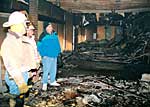Fire only one challenge for Southwest State
By Mark Steil
Minnesota Public Radio
January 29, 2002
|
| RealAudio |
Students at Southwest State University in Marshall returned to a fire-damaged campus Monday, as classes resumed nearly two weeks later than scheduled. For the past month, construction crews have been working to get the school ready after a Jan. 2 fire gutted a food service building. It's the latest headache for a school wrestling with the same budget and tuition issues affecting other state universities.
| |
|
|
|
||
All that's left of the destroyed building is a hole in the ground. Southwest State University President David Danahar took over as president last July, and says a $20 million fire was definitely not the way he wanted to begin his term. Several smoke-damaged buildings are not open as classes resume this week.
Several temporary office trailers have been wheeled onto campus to replace the lost buildings. Some art and music classes likely will be held in them. Hot meals are being served from a mobile kitchen. Still, Danahar says it's a different campus. He says everyone must pull together.
"Occasionally I use that as a slogan - do more with less. Well, this is not what I mean when I say that," Danaher says.
Doing more with less is something Southwest and the other state universities have grown used to. Doug Sweetland was president of Southwest State University from 1994 until 2000. He says the fire complicates a budget balancing act which he remembers as his greatest problem.
"Seemed like every day we were fighting one type of budget problem or another, and that's not terribly much fun," says Sweetland.
Southwest State is not alone. Funding is a top concern at each of the the seven state universities in Minnesota. They're part of a higher education system that includes the state's community and technical colleges.
Even with the financial concerns, Southwest State for several years has scored high in a magazine ranking of colleges. This year it holds the top spot for one classification in the U.S. News and World Report survey.
| |
|
|
|
||
Sweetland says it's a nice accolade, but feels the college could be doing even better. His main complaint is that even though the '90s were generally a boom time in state revenues, state universities didn't share in the good times.
"It's the first time of economic growth that I have ever seen in 30 years of education, where the amount of money that we had to work with after inflation here at Southwest State - and especially on a per-student basis - declined, declined, declined," Sweetland says.
As with most financial arguments, the question of whether state aid for higher education is increasing or decreasing depends on perspective. Legislative staff say the amount of aid per student increased during Sweetland's time. But they admit if inflation is factored in, it's possible there was a small decrease.
But one fact no one disputes is that rising college costs hit students hardest. Marty Brandl, president of the Southwest State University Student Association, says he's tired of tuition hikes.
"They go up every year. It's almost like a fact of life, just like the changing of the seasons, the tuition goes up. Tuition went up 9.9 percent last year," Brandl says.
And that wasn't even close to the worse case. Bemidji State University topped all contenders with a 17.5 percent increase. Minnesota State at Mankato hiked tuition 13 percent. And there's more ahead. Southwest State's Brandl says talk is circulating about another 10 percent increase this year. He blames the Legislature.
| |
|
|
|
||
"We've had surpluses for the last few years, and we just end up giving it back - give everybody back $100 or something....Take care of what needs to be done before you start saying we have all this extra. There really isn't a surplus if things aren't being taken care of like they're supposed to be," Brandl says.
The state budget deficit could make things even worse. State Rep. Peggy Leppik chairs the House Higher Education Finance Committee. She says colleges will share in state budget cutbacks, which probably means more tuition hikes. But she says the state has tried to offset tuition increases by making more financial aid available to students.
Leppik says under state law, the Legislature must provide two-thirds of the higher education budget. She doubts the state is meeting that obligation.
"We really are not reaching the kind of support that I think was intended orginally, or that was the policy for many years. As higher eduction costs have really ballooned, we have not kept up," Leppik says.
Former Southwest State President Doug Sweetland agrees, but goes one step further. He says educational quality is slipping at the state universities.
"Given the budget constraints we had, quality had to deteriorate. The classes out there are larger now," Sweetland says. "I think that's really sad, because one of the reasons that students come to a place like Southwest State was because of the closeness, the rapport between faculty and students, and things of that nature. And if you lose that, these students are going to quit coming here."
For current Southwest State University President David Danahar, the fire overwhelms all other considerations. He says the fire left a feeling of helplessness because no one could control it once the flames began.
At least in the budget battle, he gets to argue. But so will many others. In the push and pull of state higher education policy, these competing voices will decide what sort of future schools like Southwest State University have.
More Information


